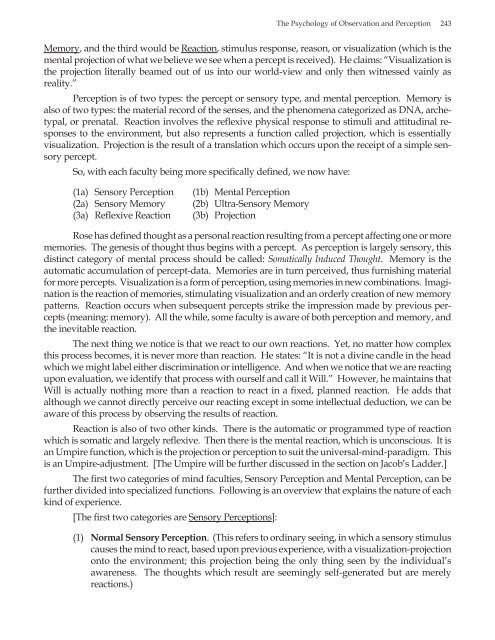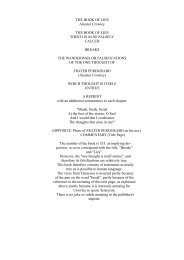Richard Rose’s Psychology of the Observer The Path to Reality Through the Self
John-Kent-Richard-Rose's-Psychology-of-Observer-Path-to-Reality-Thru-the-Self
John-Kent-Richard-Rose's-Psychology-of-Observer-Path-to-Reality-Thru-the-Self
You also want an ePaper? Increase the reach of your titles
YUMPU automatically turns print PDFs into web optimized ePapers that Google loves.
<strong>The</strong> <strong>Psychology</strong> <strong>of</strong> Observation and Perception 243<br />
Memory, and <strong>the</strong> third would be Reaction, stimulus response, reason, or visualization (which is <strong>the</strong><br />
mental projection <strong>of</strong> what we believe we see when a percept is received). He claims: “Visualization is<br />
<strong>the</strong> projection literally beamed out <strong>of</strong> us in<strong>to</strong> our world-view and only <strong>the</strong>n witnessed vainly as<br />
reality.”<br />
Perception is <strong>of</strong> two types: <strong>the</strong> percept or sensory type, and mental perception. Memory is<br />
also <strong>of</strong> two types: <strong>the</strong> material record <strong>of</strong> <strong>the</strong> senses, and <strong>the</strong> phenomena categorized as DNA, archetypal,<br />
or prenatal. Reaction involves <strong>the</strong> reflexive physical response <strong>to</strong> stimuli and attitudinal responses<br />
<strong>to</strong> <strong>the</strong> environment, but also represents a function called projection, which is essentially<br />
visualization. Projection is <strong>the</strong> result <strong>of</strong> a translation which occurs upon <strong>the</strong> receipt <strong>of</strong> a simple sensory<br />
percept.<br />
So, with each faculty being more specifically defined, we now have:<br />
(1a) Sensory Perception<br />
(2a) Sensory Memory<br />
(3a) Reflexive Reaction<br />
(1b) Mental Perception<br />
(2b) Ultra-Sensory Memory<br />
(3b) Projection<br />
Rose has defined thought as a personal reaction resulting from a percept affecting one or more<br />
memories. <strong>The</strong> genesis <strong>of</strong> thought thus begins with a percept. As perception is largely sensory, this<br />
distinct category <strong>of</strong> mental process should be called: Somatically Induced Thought. Memory is <strong>the</strong><br />
au<strong>to</strong>matic accumulation <strong>of</strong> percept-data. Memories are in turn perceived, thus furnishing material<br />
for more percepts. Visualization is a form <strong>of</strong> perception, using memories in new combinations. Imagination<br />
is <strong>the</strong> reaction <strong>of</strong> memories, stimulating visualization and an orderly creation <strong>of</strong> new memory<br />
patterns. Reaction occurs when subsequent percepts strike <strong>the</strong> impression made by previous percepts<br />
(meaning: memory). All <strong>the</strong> while, some faculty is aware <strong>of</strong> both perception and memory, and<br />
<strong>the</strong> inevitable reaction.<br />
<strong>The</strong> next thing we notice is that we react <strong>to</strong> our own reactions. Yet, no matter how complex<br />
this process becomes, it is never more than reaction. He states: “It is not a divine candle in <strong>the</strong> head<br />
which we might label ei<strong>the</strong>r discrimination or intelligence. And when we notice that we are reacting<br />
upon evaluation, we identify that process with ourself and call it Will.” However, he maintains that<br />
Will is actually nothing more than a reaction <strong>to</strong> react in a fixed, planned reaction. He adds that<br />
although we cannot directly perceive our reacting except in some intellectual deduction, we can be<br />
aware <strong>of</strong> this process by observing <strong>the</strong> results <strong>of</strong> reaction.<br />
Reaction is also <strong>of</strong> two o<strong>the</strong>r kinds. <strong>The</strong>re is <strong>the</strong> au<strong>to</strong>matic or programmed type <strong>of</strong> reaction<br />
which is somatic and largely reflexive. <strong>The</strong>n <strong>the</strong>re is <strong>the</strong> mental reaction, which is unconscious. It is<br />
an Umpire function, which is <strong>the</strong> projection or perception <strong>to</strong> suit <strong>the</strong> universal-mind-paradigm. This<br />
is an Umpire-adjustment. [<strong>The</strong> Umpire will be fur<strong>the</strong>r discussed in <strong>the</strong> section on Jacob’s Ladder.]<br />
<strong>The</strong> first two categories <strong>of</strong> mind faculties, Sensory Perception and Mental Perception, can be<br />
fur<strong>the</strong>r divided in<strong>to</strong> specialized functions. Following is an overview that explains <strong>the</strong> nature <strong>of</strong> each<br />
kind <strong>of</strong> experience.<br />
[<strong>The</strong> first two categories are Sensory Perceptions]:<br />
(1) Normal Sensory Perception. (This refers <strong>to</strong> ordinary seeing, in which a sensory stimulus<br />
causes <strong>the</strong> mind <strong>to</strong> react, based upon previous experience, with a visualization-projection<br />
on<strong>to</strong> <strong>the</strong> environment; this projection being <strong>the</strong> only thing seen by <strong>the</strong> individual’s<br />
awareness. <strong>The</strong> thoughts which result are seemingly self-generated but are merely<br />
reactions.)




